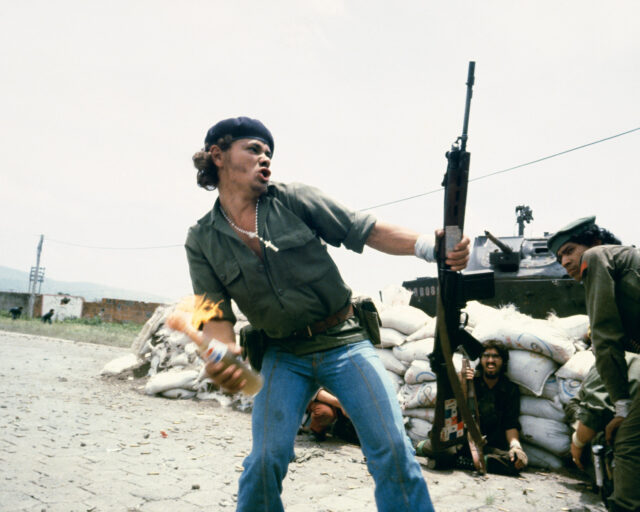Dispatches: Istanbul
In Istanbul’s photography scene, the anxious aftermath of a violent year.
Charlie Kirk, Okmeydani, Istanbul, Berkin Elvan protest, 2013
“A photograph can be incredibly intimidating for cops,” Tuğba Tekerek, a Turkish journalist, told me recently. “They can use it to crush you.”
The last twelve months have seen Turkey navigate an accumulation of violent incidents and growing surveillance; with them, the environment for photographers has changed for the worse. In this country, which occasionally tops the New York–based Committee to Protect Journalists’s annual list of the world’s leading jailers of journalists, taking pictures is an increasingly political and dangerous act.

Courtesy the artist
Tekerek, arrested twice last year for photographing people in public spaces, was speaking from experience. When we met at a Caffè Nero one quiet morning last September, Istanbul had not fully awoken from the nightmares of 2016. ISIS suicide attacks on Istanbul’s main shopping avenue in March and in its airport last June, followed by a coup attempt by a religious cult that ended up killing hundreds of civilians in July, unsettled the city.
“Taking pictures here has turned into a big problem only in the past three years, following Gezi,” she said, referring to violent protests around Istanbul’s Taksim Gezi Park in 2013. Intent on documenting human rights violations, Tekerek often photographs in civic areas—the corridor of a courtroom, the garden of a police station. But these are the kinds of images likely to land the reporter behind bars. On the occasions Tekerek has been taken into custody, police officers have asked whether she is a terrorist studying the area for an attack. Twice, cops confiscated her camera and placed her in a locked room. Tekerek’s supposed crime, meanwhile, stays the same: her pictures contain images of uniformed or plainclothes police officers.

© the artist/AFP/Getty Images
Charlie Kirk, a British photographer, made the same discovery when he arrived in Istanbul in the summer of 2012, following a career as a derivatives lawyer. “I was amazed by the number of protests on İstiklal Avenue,” Kirk recalled. The 2013 protests at Gezi Park were a revelation for him. His first night photographing, on May 29, when tens of thousands packed the avenue and helicopters dropped tear gas on them, was burned onto his mind. Kirk produced a series of images using what the Australian photographer Rob Vallender describes as Kirk’s gonzo style: an aggressive approach toward his subjects, whose unsuspecting faces he illuminates with an off-camera flash. With raw and clear-eyed realism, Kirk captured protests in the wake of the suppression of the Gezi uprising and the unrest in ethnically diverse Istanbul neighborhoods. He plans to publish his protest photographs in a book, but not in Turkey, where he fears censorship.
A few days after speaking with Kirk in September 2016, I paid a visit to the offices of Geniş Açı, a collective and formerly a prestigious photography magazine that ceased publication after producing fifty issues between 1997 and 2006. Refik Akyüz and Serdar Darendeliler, the duo who run the initiative, had sad news to share: the World Press Photo traveling exhibition, which they had been responsible for organizing at Forum Istanbul since 2009, usually opens every August, but there was no attempt by World Press Photo to renew the contract for an exhibition in 2016.
“The photography community here is used to attending the premiere every year at the end of August,” Darendeliler said. “People were telephoning us to ask when the opening would be.”

© and courtesy the artist
Akyüz and Darendeliler felt that the nonrenewal must have been political. In particular, they suspected the presence of a singular image by Mauricio Lima in the exhibition as possibly being the cause. Lima’s photograph shows a doctor treating a sixteen-year-old ISIS militant at a hospital in northern Syria. A framed portrait of Abdullah Öcalan, the imprisoned leader of the Kurdish armed movement PKK, hangs in the background. (Turkish officials consider PKK—which routinely attacks Turkish security forces—and ISIS to be equally violent terrorist groups.) When Lima’s photograph won the World Press Photo Contest’s first prize in the general news category in February last year, Akyüz and Darendeliler received an email from the organization’s Amsterdam office, inquiring whether the image would cause an issue. But World Press Photo, in response to my question about the exhibition, stated, “Our exhibition requires local partners for it to be organized in each location and local partners are not always available.”
“We have never encountered censorship while editing our magazine,” Akyüz said. “In 2007, we organized an exhibition in Bursa, with lots of nude images. The mayor, a member of the conservative ruling party, came to visit, looked at the images, and just walked by.” In 2015, Bülent Kılıç’s photograph of a young girl wounded during clashes in Istanbul received a World Press Photo Award and was exhibited without any problems.
Whether censorship or conservative caution was at play with the failure to present the exhibition in Istanbul, the atmosphere is more stark in eastern Turkey. Tuğba Tekerek told me of photographers who, when attempting to take pictures in war-ridden areas, were met with willful intimidation from military snipers. In one case, a photographer visibly shaken by the riot gear and machine guns was asked by a special operations police officer, “Why are you so scared of my machine gun? Your camera is more powerful than my gun, and much scarier.”
Read more from Aperture Issue 226 “American Destiny,” or subscribe to Aperture and never miss an issue.























